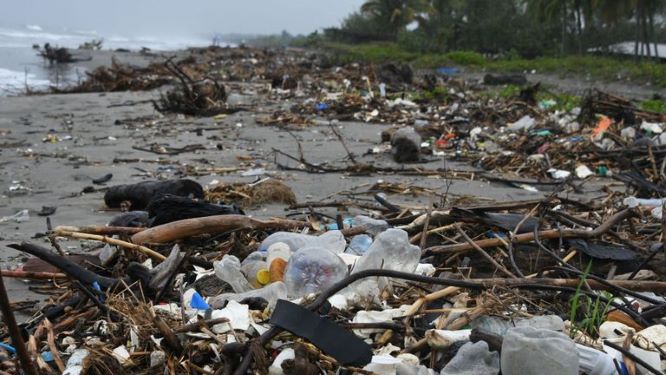As The Festive Season Begins So Does the Pressure on India’s Environment

‘Tis the season to be jolly in India with back-to-back festivals beginning with Ganesh Chaturthi and now Navratri, Durga Puja, Diwali, Saraswati Puja and then Chhat. And the season to take care of the environment too as festivities also mean rampant assault on natural resources, polluting India’s water, wind, land and air.
Beginning September and till November, India’s many festivals see congregations of the devout visiting makeshift pandals for worship and then participating in many bhandaras and bhogs which serve free food.
Despite laws and guidelines laid down for idols, Plaster of Paris is still used in making idols and non-biodegradable styrofoam disposable cutlery used for serving food. Thermocol decorations, lead-based paints and even polluting kerosene and diesel gensets are deployed in areas which don’t have adequate grid supply for elaborate light decorations.
#Polythene_Ban but what abt these #thermocol_plates most #hazardous 4 #Environment, #Bhandara 4 ppl & deteriorating nature @dm_ghaziabad pic.twitter.com/Ful5mWpstZ
— RishiRaman (@Rishi_IHA) October 28, 2017
And then comes the assault on our seas, rivers, lakes and local water bodies during the time of idol immersion. Visual reminders in the form of idols made of POP, thermocol decorations and other non-biodegradable material floating near the shore or on the surface haunts us every year and reminds us of the promises made but not enforced, kept or simply broken.
Keeping in mind the religious sensitivities involved, environmentalists, lawmakers and enforcers reach out to the organisers to ensure compliance but then simple economics, past precedents and tradition often come in the way of doing what is right for the environment.
Next is the cherry on top: Diwali, the festival of lights. With multiple factors causing a spike in air pollution, Diwali firecrackers usually find themselves at the wrong end of environmentalists’ ire every year now.
Bursting firecrackers not only adds to the noise and air pollution, but the remnants of a night of celebration in the form of leftover debris also clog the drains or find their way to the groundwater and other water bodies, polluting them with their harmful chemical residues.
Toxic smog: Air pollution in New Delhi hits hazardous levels after a night of free-for-all Diwali fireworkshttps://t.co/0yS6VxJzUt pic.twitter.com/GY9BOUOEKI
— AFP news agency (@AFP) November 8, 2018
India’s top court has made strict guidelines for Diwali, cracking down on the duration of bursting firecrackers, type and the sound level of the crackers that will be made available for sale but in a vast country like India, the demand is much much more than the supply of the so-called ‘green crackers’.
The central government, the National Green Tribunal, the Supreme court, and the state governments are making every effort possible to control pollution by enacting laws, strict guidelines and even imposing penalties on the lawbreakers.
And since Durga Puja and Chhat festivities are predominantly east India centred – the states around the Ganga basin – the National Mission for Clean Ganga has issued a directive imposing a fine of Rs 50,000 for idol immersion in river Ganga, its tributaries and on their banks, the Indian Express newspaper reported.
Corporation workers collect the remnants of goddess Durga idols after immersion to avoid pollution of river Ganga in Kolkata after Durga puja ends (PTI) via @yamunajiye pic.twitter.com/Pbw3DuVPjg
— Manipadma Jena (@ManipadmaJena) November 24, 2018
“No idol immersion into river Ganga and its tributaries and on their banks and all concerned state government, authority, board or corporation should ensure that there is no use of synthetic material/ non-biodegradable material, Plaster of Paris (POP), baked clay, resin fibers and thermocol for making of idols. Besides, the use of toxic and non-biodegradable chemical dyes or synthetic paints for painting of idols should be strictly prohibited,” the Indian Express report quoted the directive issued by the mission.
But making and then enforcing directives and laws is easier said than done. It is often the initiative taken by the organisers and volunteers which ensures compliance in letter and spirit, without discrediting or hurting religious sentiments or faith.
@SwachhBharatGov @MoHUA_India #mycleanindia
Bhandara organised by Bharat Apptt I.P. Ext Delhi as per guidelines issued by MoHUA ,No plastic ,no thermocol erc pic.twitter.com/2CaqMnyNxF— Rajiv Kumar Jain (@rajivjain1962) April 14, 2019
Many big Durga Puja pandals of Delhi were already immersing their idols in makeshift ponds like a few in Delhi’s Chittaranjan Park where they dug an area next to the pandal for Bhaashaan.
The conflict between the purity of natural resources like the river Ganga and faith will remain a lifelong matter of study but the imminent clear and present danger of polluting the gifts of nature to levels where there is no way back is what needs our collective attention.
Of course, convincing people would be a lot easier if the ill effects of pollution to the river, and its sources, was done through the year.
While hundreds of Durga idols are headed to the yamuna for immersion, CR Park leading the way in ecofriendly immersion. These two pits will be used as compost sites #DurgaPuja #pollution pic.twitter.com/qpbHnGd0hB
— Snigdha Basu (@SnigdhaBee) October 19, 2018
While inaugurating the 6th India Water Week last month, President Ram Nath Kovind said that making Ganga and our other rivers clean cannot be a mission of the government alone.
“As citizens, we must contribute to this cause. For instance, we recently celebrated Ganesh Chaturthi and Navratras are a few days away. We need to ensure that the idols of deities immersed in the rivers are made of environment-friendly materials. It will help keep the rivers clean and ensure the safety of marine life,” President Kovind had said.
Bakers at Sarabha Nagar in Ludhiana prepared a Ganpati idol using 106 kg of pure dark Belgian chocolate. The idol will be immersed in milk for Ganesh Visarjan and chocolate milkshake will be served to underprivileged children.#ExpressPhoto by Gurmeet Singh pic.twitter.com/TS7xg5tN4L
— Express Photo (@ExpressImages) September 3, 2019
Of course, one wishes that the festival season would not be treated as a wake-up call to harangue the polluters but to celebrate the achievements of the time before it to keep these sources clean.
In fact, common sense tells us that it is during times like these that the common man expects a little more leeway (generosity, to stretch it) when it comes to the rules with religious sentiments invoked. Thus, starting the process of clean up and preparations much earlier would seem to be the obvious thing to do.
Fines are at best deterrents, guidelines and directives ink on paper but the real worship for the devout shall be safeguarding the environment this festival season, and beyond.




